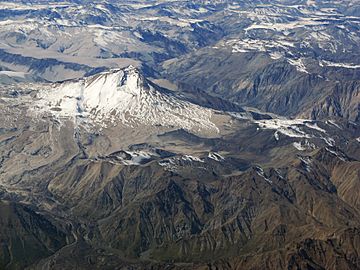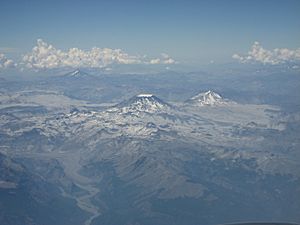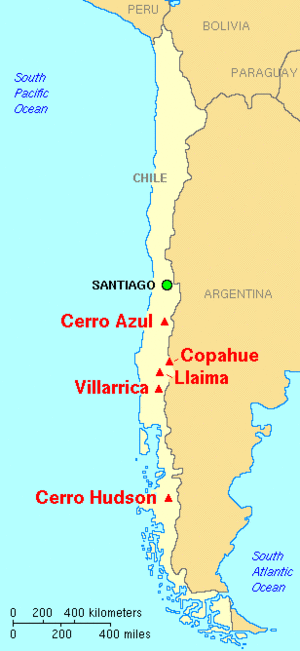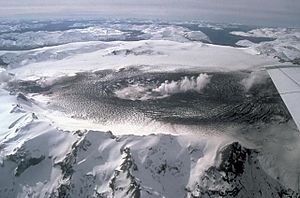Cerro Azul (Chile volcano) facts for kids
Quick facts for kids Cerro Azul |
|
|---|---|

Aerial view of Cerro Azul from the west.
|
|
| Highest point | |
| Elevation | 3,788 m (12,428 ft) |
| Listing | List of volcanoes in Chile |
| Geography | |
| Location | Chile |
| Parent range | Andes |
| Geology | |
| Age of rock | Quaternary |
| Mountain type | Stratovolcano |
| Volcanic arc/belt | South Volcanic Zone |
| Last eruption | August 1967 |
Cerro Azul (which means blue hill in Spanish) is an active stratovolcano in central Chile. It is sometimes called Quizapu. This volcano is part of the South Volcanic Zone of the Andes mountains.
Cerro Azul stands 3,788 meters (12,428 ft) tall. At its top, there's a crater about 500 meters (1,600 ft) wide. Below the top, you can find many smaller volcanic cones and vents.
This volcano has caused some of South America's biggest eruptions ever recorded. Huge eruptions happened in 1846 and 1932. In 1846, a new vent called Quizapu crater formed. Lava flowed out, covering an area of 8–9 square kilometres (3–3.5 square miles). Between 1907 and 1932, smaller eruptions helped shape this crater.
In 1932, one of the 20th century's largest explosive eruptions happened at Quizapu Crater. It shot 9.5 cubic kilometers (2.3 cu mi) of ash high into the sky! The volcano's most recent eruption was in 1967.
The South Volcanic Zone has a long history of eruptions. Volcanoes here can be dangerous. Things like ashfall or fast-moving pyroclastic flows can be risky for people and animals. Even though Cerro Azul has been quiet, it could erupt again. If it did, groups like the Volcano Disaster Assistance Program (VDAP) are ready to help. They can evacuate, assist, and rescue people.
Contents
What is Cerro Azul?
Where is it located?

Volcanoes in the Andes mountains of Chile form because two huge pieces of Earth's crust, the Nazca and Antarctic plates, are sliding under the South American Plate. This process is called subduction.
Chile has three main areas where volcanoes are found: the Central, South, and Austral Volcanic Zones. Cerro Azul is in the South Volcanic Zone. This area is the most active in Chile, with about one eruption each year.
There are almost 100 separate volcanoes in Chile that have been active in the last 2.6 million years. Out of 200 historically active volcanoes in the Andes, 36 are in Chile.
How was it formed?
Cerro Azul is only 7 kilometers (4.3 mi) south of another volcano, Descabezado Grande. Both are part of a larger volcanic area. These volcanoes sit on top of a wide, flat area called the Casitas Shield. This shield was built up by over 100 lava flows that erupted a long time ago.
Like most Andean volcanoes, Cerro Azul is a stratovolcano. This means it's made of many layers of volcanic ash and lava flows. The cone of Cerro Azul is quite young. It formed in the last 11,700 years. It's made of hardened volcanic rock and some dacite–andesine lavas.
Cerro Azul has several craters. Most of its eruptions in recorded history have come from Quizapu Crater. Other craters on its sides include Caracol ("Snail") and Crater sin Nombre ("Nameless Crater"). The very top of Cerro Azul has a crater about 500 meters (1,640 ft) wide.
Quizapu Crater
Quizapu is the most famous crater on Cerro Azul. It formed during the 1846 eruption. It's also known as Cerro del Medio ("Middle Hill") or Volcan Nuevo ("New Volcano").
The crater was shaped by eruptions between 1907 and 1932. A huge Plinian eruption in 1932 made it even bigger. This single event shot out as much lava as all other Quizapu eruptions combined since 1846.
The Quizapu Crater is almost perfectly round. It rises 150 to 250 meters (490 to 820 ft) above the surrounding volcano. At 3,292 meters (10,801 ft) high, Quizapu is one of the highest known Plinian craters. The crater is surrounded by rock and ash from its 1932 eruption.
Weather and Plants
Cerro Azul is in an area with a Mediterranean climate. This means it has hot, dry summers and mild, wet winters. Temperatures and rainfall depend a lot on how high up you are.
In the Andes, summer temperatures are usually between 20 to 25 °C (68 to 77 °F). Winter temperatures drop below 0 °C (32 °F). The area gets up to 800 mm (31.5 inches) of rain each year.
Plants in the Andes change with height. Above 1,600 meters (5,249 ft), you'll find Alpine-like steppe plants. Below that, there are different types of forests and matorral (shrubs). There are likely over 2,000 plant species in central Chile.
History of Eruptions
Cerro Azul has been erupting since at least 1846. It has had lava flows, explosive eruptions, and steam-driven eruptions. Some explosive eruptions also caused pyroclastic flows (fast-moving hot gas and rock).
The first recorded eruption started on November 26, 1846. The volcano's last eruption began on August 9, 1967. Cerro Azul has caused two of the biggest eruptions in South America's recorded history, in 1846 and 1932. Both released about 4–5 cubic kilometers (1.0–1.2 cu mi) of magma.
First Eruption: 1846
On November 26, 1846, Cerro Azul erupted for the first time that we know of. Local herdsmen heard a "great noise and a cloud of ash" from the mountain. They didn't report any earthquakes before the eruption.
That night, herdsmen heard a loud roar, with bangs and crackling sounds. They saw blue flames and smelled strong sulfur gas. People 85 kilometers (53 mi) away in Talca heard the eruption and smelled the sulfur the next day.
This first eruption was a lava flow. It created the Quizapu vent. Lava flowed into nearby valleys. By November 28, the volcano seemed quiet. People found a field of rocky lava that was still hot and steaming. This lava field grew to be twice its original size by 1992.
Early 1900s Activity
Cerro Azul was quiet from 1846 until the early 1900s. After a possible small eruption in 1903, it erupted again in 1907. Between 1907 and 1914, ash clouds often rose from the crater. On September 8, 1914, an explosive eruption sent a plume 6 or 7 kilometers (about 4 mi) into the air. By 1916, these eruptions had created a crater much like the one we see today.
The volcano also had several steam-driven eruptions. Its activity increased from 1916 to 1926. During these years, eruptions became more frequent and stronger. A big eruption on November 2, 1927, started a period of almost constant, strong eruptions that lasted until 1929. During this time, Cerro Azul sometimes erupted daily, sending ash columns 6 or 7 kilometers (about 4 mi) high.
Major Eruption: 1932
| 1932 eruption of Cerro Azul | |
|---|---|
| Type | Plinian |
| VEI | 5 |
Before 1932, Quizapu had many steam eruptions and one lava flow, but no large explosive ones. This frequent small activity was a sign of a major eruption to come. On January 25, 1932, people saw a large black cloud over the volcano. By April 9, the volcano was letting out green gas and making loud noises.
On April 10, Cerro Azul finally erupted. It released a huge column of white gas. Later, the plume turned black with ash and spread out like an umbrella. Wind carried the ash to Argentina, about 47 kilometers (29 mi) away, where it rained down for hours.
Cerro Azul's April 1932 eruption was one of the biggest of the 20th century. It shot out 9.5 cubic kilometers (2 cu mi) of ash and rock. The eruption columns reached 27–30 kilometers (17–19 mi) into the air! Soon after, nearby volcanoes, Tinguiririca and Descabezado Grande, also started erupting. This eruption was so powerful it was given a Volcanic Explosivity Index (VEI) of at least 5.
Since the 1932 eruption, Quizapu has been mostly quiet. Small ash clouds were reported in 1949 and 1967. In the 1980s, there were only signs of steam vents.
Dangers and Safety
Cerro Azul is in the South Volcanic Zone, where many volcanoes can be dangerous. Other active volcanoes here include Mount Hudson, Llaima, and Villarrica. These volcanoes have erupted many times since 1558.
All types of eruptions have happened in this region. Cerro Azul itself has had steam-driven, Strombolian (small, frequent explosions), and Plinian (very large, explosive) eruptions.
Volcanic dangers from Cerro Azul and the surrounding area can take many forms. Past eruptions have caused lahars (mudflows), lava flows, and ashfalls. Lava flows and lahars could destroy towns. Ashfall from explosive eruptions can stop air travel. The most dangerous risk is pyroclastic flows, which have traveled as far as 100 kilometers (62 mi) in the region.
The 1932 eruption of Quizapu Crater sent huge amounts of ash all the way to Brazil. After that eruption, plants in the area were destroyed. The land stayed barren until the 1990s. Even though the eruptions were huge, the danger to people from Quizapu is fairly small because Cerro Azul is in a remote area.
However, scientists are still concerned because of how big past eruptions have been. There might be a large amount of magma deep under Cerro Azul. If so, past eruptions might have just been small leaks. A much larger, caldera-forming eruption could happen in the future.
If Cerro Azul were to erupt, help would be organized quickly. The Volcanic Disaster Assistance Program (VDAP) was created after the famous 1985 eruption of Nevado del Ruiz in Colombia. This team helps reduce deaths and economic losses from eruptions in developing countries. VDAP has special equipment to monitor volcanoes and predict eruptions. This helps them evacuate nearby homes quickly and safely.
See also
 In Spanish: Volcán Quizapú para niños
In Spanish: Volcán Quizapú para niños
- Geology of Chile
- List of volcanoes in Chile
Images for kids
-
The mountain with the appearance of a truncated cone, at the centre of the image, is Descabezado Grande volcano, and close to it is the pyramidal Cerro Azul.
-
Glaciers around a black caldera from which steam is rising. Mount Hudson, an active volcano in the SVZ, shortly after an eruption in 1991. The volcano has produced eruptions as powerful as Volcanic Explosivity Index degree six.








